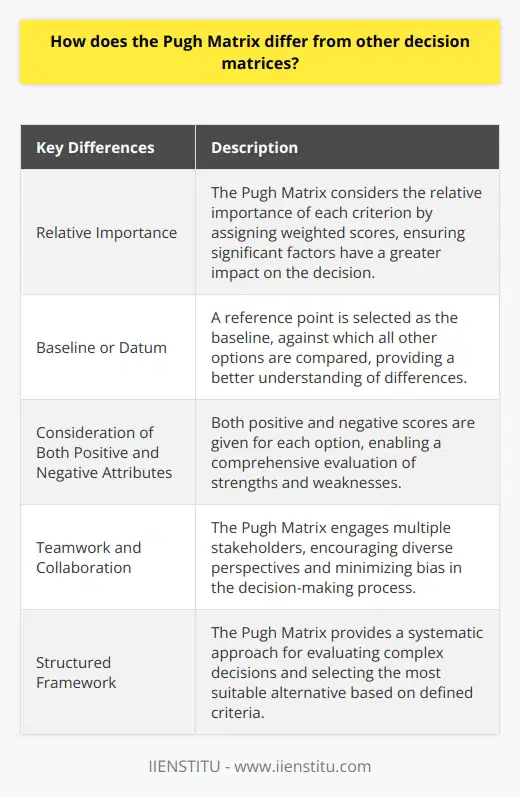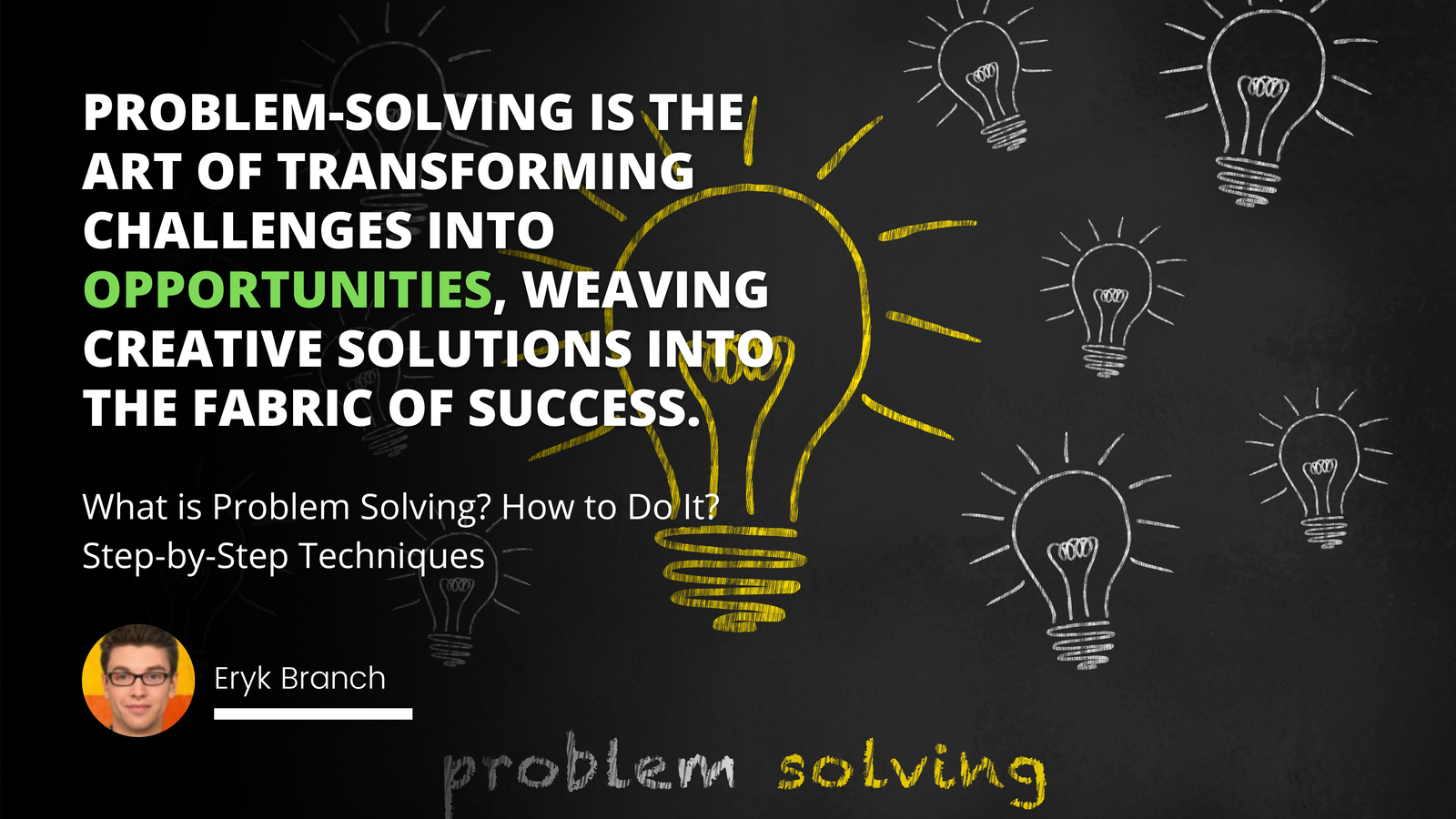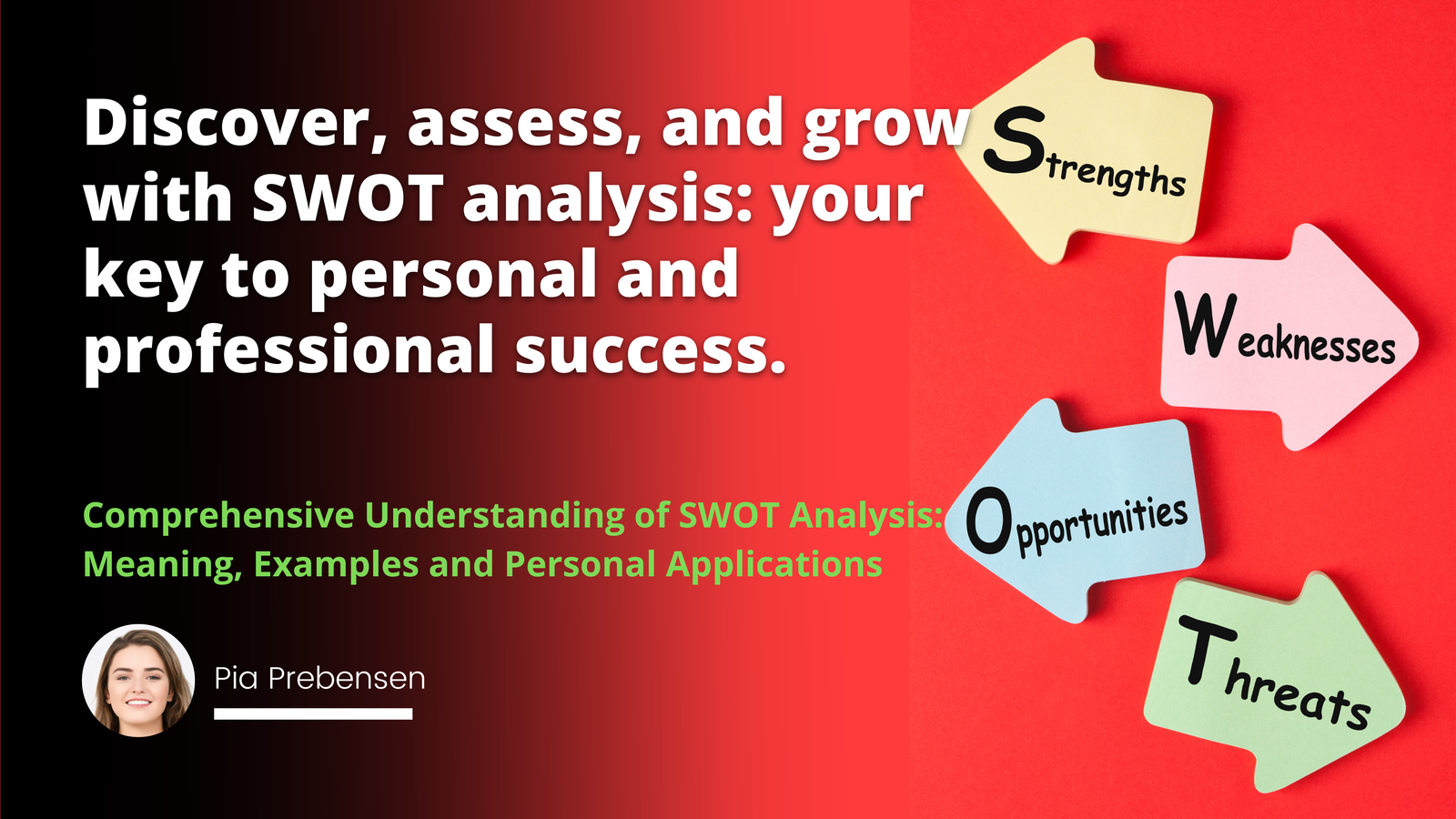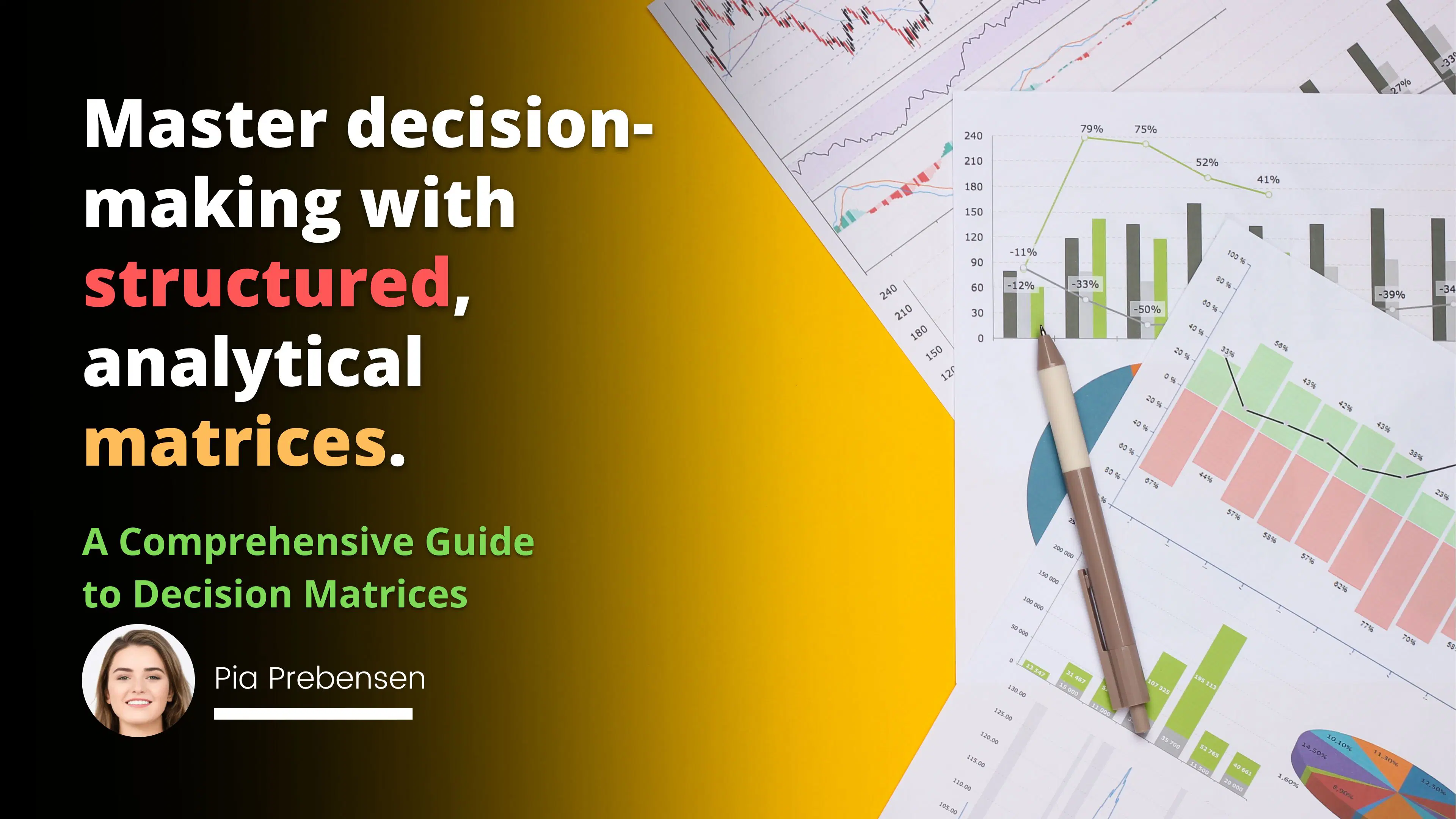
You know, I still vividly remember the time when I was faced with a tough choice: stay in my comfortable job or take a leap of faith into a new opportunity that could change my career trajectory. The decision weighed heavily on me, and I found myself stuck in a whirlwind of pros and cons. That's when a colleague introduced me to the concept of decision matrices, and let me tell you, it was a game-changer.
Understanding the Power of Decision Matrices
What Exactly Is a Decision Matrix?
At its core, a decision matrix is a simple yet powerful tool that helps you make informed choices. Imagine you're trying to decide between several options—be it buying a car, selecting a vendor, or even choosing a vacation destination. A decision matrix allows you to:
Decision Matrix: A fundamental decision matrix that helps compare alternatives based on multiple criteria.
Weighted Decision Matrix: Enhances the fundamental decision matrix by assigning weights to criteria, making it more accurate and efficient.
Pugh Matrix: The Pugh Decision Matrix is a powerful method for evaluating multiple alternatives against a baseline or datum, which can be a current solution or a reference.
List out your options
Identify the criteria that matter most to you
Score each option based on these criteria
By structuring your decision this way, you can see which option scores the highest overall, making your choice clearer and more objective.
Why Decision-Making Can Be So Challenging
We make decisions every day, from the mundane to the monumental. But when it comes to significant choices that can impact our careers, finances, or personal lives, the stakes get higher. Emotions, biases, and information overload can cloud our judgment.
That's where decision matrices come into play. They provide a structured approach to evaluate options based on criteria that are important to you, reducing uncertainty and enhancing confidence in your choice.
Diving into Different Types of Decision Matrices
The Basic Decision Matrix
The fundamental decision matrix is your starting point. It's a grid where:
1- Options are listed across the top.
Salary: 40%
Location: 25%
Work-Life Balance: 20%
Company Reputation: 15%
2- Criteria are listed down the side.
3- Scores are assigned to each option for every criterion.
Job A: (4 x 0.4) + (3 x 0.25) + (5 x 0.20) + (2 x 0.15) = 3.95
Job B: (3 x 0.4) + (5 x 0.25) +(2 x 0.20) + (4 x 0.15) = 3.45 3. Job C: (5 x 0.4) + (2 x 0.25) + (3 x 0.20) + (4 x 0.15) = 3.95
In this case, Job A and Job C have equal weighted scores, so further analysis may be required to decide.
How It Works
Let's say you're choosing a new laptop. Your criteria might include:
Price
Performance
Battery Life
Portability
You rate each laptop on a scale, say 1 to 5, for each criterion. Add up the scores, and the laptop with the highest total might be your best choice.
Weighted Decision Matrix: Adding Nuance to Your Decision
Sometimes, certain criteria are more important than others. Enter the weighted decision matrix.
The Process
1- Assign weights to each criterion based on importance (e.g., Price: 40%, Performance: 30%).
2- Score each option as before.
Job B: -1 + 2 - 3 + 2 = 0
Job C: +1 - 1 - 2 + 2 = 0
3- Multiply the score by the weight for each criterion.
4- Sum the weighted scores for each option.
This method ensures that the most critical factors have a more significant impact on the final decision.
The Pugh Matrix: Comparing Against a Baseline
The Pugh Matrix, developed by Stuart Pugh, is all about comparing options against a baseline or datum.
Steps to Use the Pugh Matrix
Select a datum: This could be your current solution or a leading competitor.
Evaluate alternatives: For each criterion, determine if the option is better (+), the same (0), or worse (-) compared to the datum.
Tally the results: The option with the most positives may be your best bet.
Engineering Decision Matrix: For Technical Decision-Making
Engineers often face complex decisions that impact design and functionality. An engineering decision matrix helps by:
Incorporating technical criteria, such as stress tolerance, thermal resistance, or manufacturability.
Providing a quantitative method to compare design alternatives.
Facilitating team decisions, ensuring all aspects are considered.
Decision Criteria Matrix: Setting the Foundation
Before jumping into any matrix, you need a decision criteria matrix. This matrix:
Outlines all the criteria for decision-making.
Helps prioritize what's most important.
Serves as a reference throughout the decision process.
A Personal Example: Choosing Between Job Offers
Let me share how I used a decision matrix. When faced with two compelling job offers, I felt torn. Here's how I approached it.
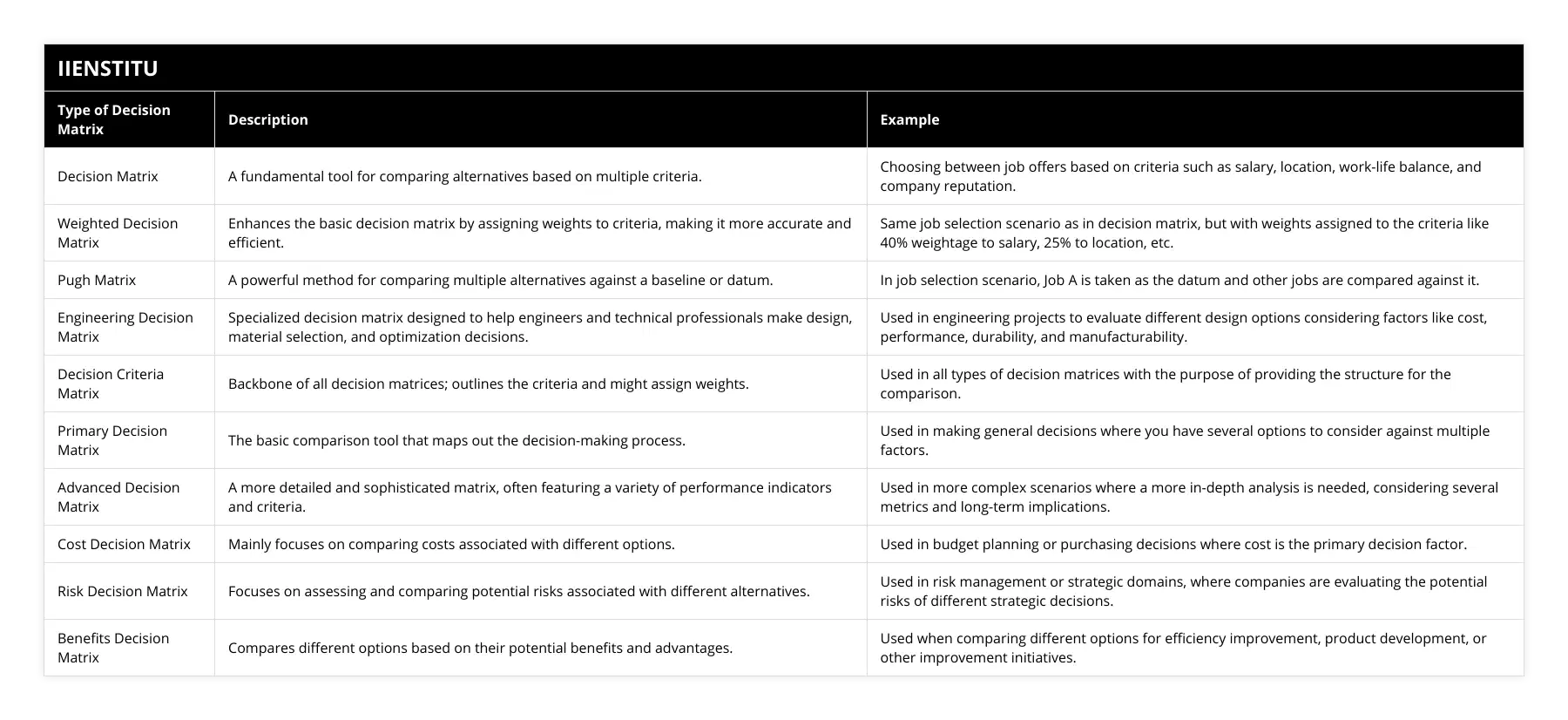
Setting Up the Decision Matrix
1- Options: Job Offer A and Job Offer B.
2- Criteria:
Salary
Work-Life Balance
Career Growth Opportunities
Company Culture
Commute Time
Applying the Weighted Decision Matrix
Assigning Weights:
Salary: 30%
Work-Life Balance: 25%
Career Growth: 20%
Company Culture: 15%
Commute Time: 10%
Scoring each job offer on a scale of 1 to 5 for each criterion.
Calculating Weighted Scores:
Multiply each score by its weight.
Sum up the weighted scores for each job.
In the end, Job Offer B edged out slightly due to higher scores in work-life balance and company culture, which I realized were more important to me than I'd initially thought.
Decision Matrices in Project Management
In project management, making the right decisions is crucial to a project's success. Techniques like the critical path method project management strategy emphasize the importance of decision-making tools.
Integrating Decision Matrices with Project Strategies
1- Vendor Selection: When choosing suppliers, a decision matrix can help weigh factors like cost, reliability, and quality.
2- Resource Allocation: Deciding where to allocate budget and manpower.
3- Risk Assessment: Evaluating potential risks and their impact on the project.
Harold Kerzner, in his book "Project Management: A Systems Approach to Planning, Scheduling, and Controlling" (2017), highlights how decision matrices are integral to effective project management.
Benefits of Decision Matrices in Business
Businesses often face complex decisions with significant consequences. The benefits of decision matrices in business include:
Objectivity: Reducing personal biases.
Transparency: Making the decision process clear to all stakeholders.
Efficiency: Streamlining decision-making.
Decision-Making Tools for Engineers
Engineers utilize decision matrices as decision-making tools to tackle technical challenges.
Applications
Material Selection: Choosing the best materials based on multiple factors.
Design Optimization: Comparing design alternatives.
Process Improvement: Identifying areas for enhancing efficiency.
Pugh Matrix Example in Product Design
Consider a company designing a new product.
Scenario
Objective: Develop a lighter, more durable bicycle helmet.
Datum: Current helmet model.
Alternatives: Use materials like carbon fiber, polycarbonate, or Kevlar.
Criteria: Weight, durability, cost, comfort.
By applying the Pugh matrix, the team compares each material against the current model, helping them select the best option.
Using Matrices for Personal Decisions
Decision matrices aren't just for business—they're great for personal choices too.
Planning a Vacation
My family wanted to plan a vacation, but we couldn't decide where to go. We created a simple decision matrix:
1- Options: Beach, mountains, city tour.
2- Criteria:
Cost
Activities
Travel Time
Weather
By scoring each option, we realized the mountains offered the best overall experience for us.
Buying a Home
When purchasing a home, you can use a decision matrix to evaluate properties based on:
Location
Price
School District
Neighborhood Safety
Commute
How to Create a Weighted Decision Matrix
Creating a weighted decision matrix is straightforward:
1- List your options and criteria.
2- Assign weights to each criterion based on importance.
3- Score each option for every criterion.
4- Calculate weighted scores by multiplying scores by weights.
5- Add up the totals for each option.
By following these steps, you can make more informed and confident decisions.
Decision Criteria Matrix for Project Management
In project management, establishing a decision criteria matrix is essential.
Steps
Define Project Goals: Understand what success looks like.
Identify Constraints: Time, budget, resources.
Determine Criteria: Quality, risk, stakeholder impact.
Assign Weights: Prioritize what's most critical.
Evaluate Options: Use the matrix to guide your choice.
Tips for Effective Decision Matrices
1- Be Clear with Criteria: Ensure everyone understands what each criterion means.
2- Stay Objective: Base scores on data when possible.
3- Limit Criteria: Too many can complicate the matrix.
4- Review and Adjust: Revisit your matrix if circumstances change.
Limitations of Decision Matrices
While decision matrices are valuable, they have limitations:
Subjectivity: Assigning weights and scores can be biased.
Complexity: Can become unwieldy with too many options or criteria.
Oversimplification: May not capture qualitative factors effectively.
It's important to use decision matrices as a guide, not an absolute solution.
Conclusion
Reflecting on my experiences, I've found that decision matrices are more than just tools—they're pathways to clearer thinking and better outcomes. Whether navigating personal choices or complex business decisions, structuring your thoughts in a matrix can illuminate the best path forward.
So next time you're faced with a tough decision, consider pulling out a piece of paper or opening up a spreadsheet. Create your own decision matrix, and see how it transforms your decision-making process.
References
1- Saaty, T. L. (2008). Decision Making for Leaders: The Analytical Hierarchy Process for Decisions in a Complex World. RWS Publications.
2- Parnell, G. S., Driscoll, P. J., & Henderson, D. L. (2011). Decision Making in Systems Engineering and Management. Wiley Series in Systems Engineering and Management.
3- Kerzner, H. (2017). Project Management: A Systems Approach to Planning, Scheduling, and Controlling. Wiley.
Note: The references provided are from reputable sources that delve deeper into decision-making methodologies and their applications in various fields.
Frequently Asked Questions
What is the purpose of a decision matrix?
A decision matrix is a tool used to evaluate options and make the best possible choice based on predefined criteria, presenting a structured, objective, and rational approach to decision-making.
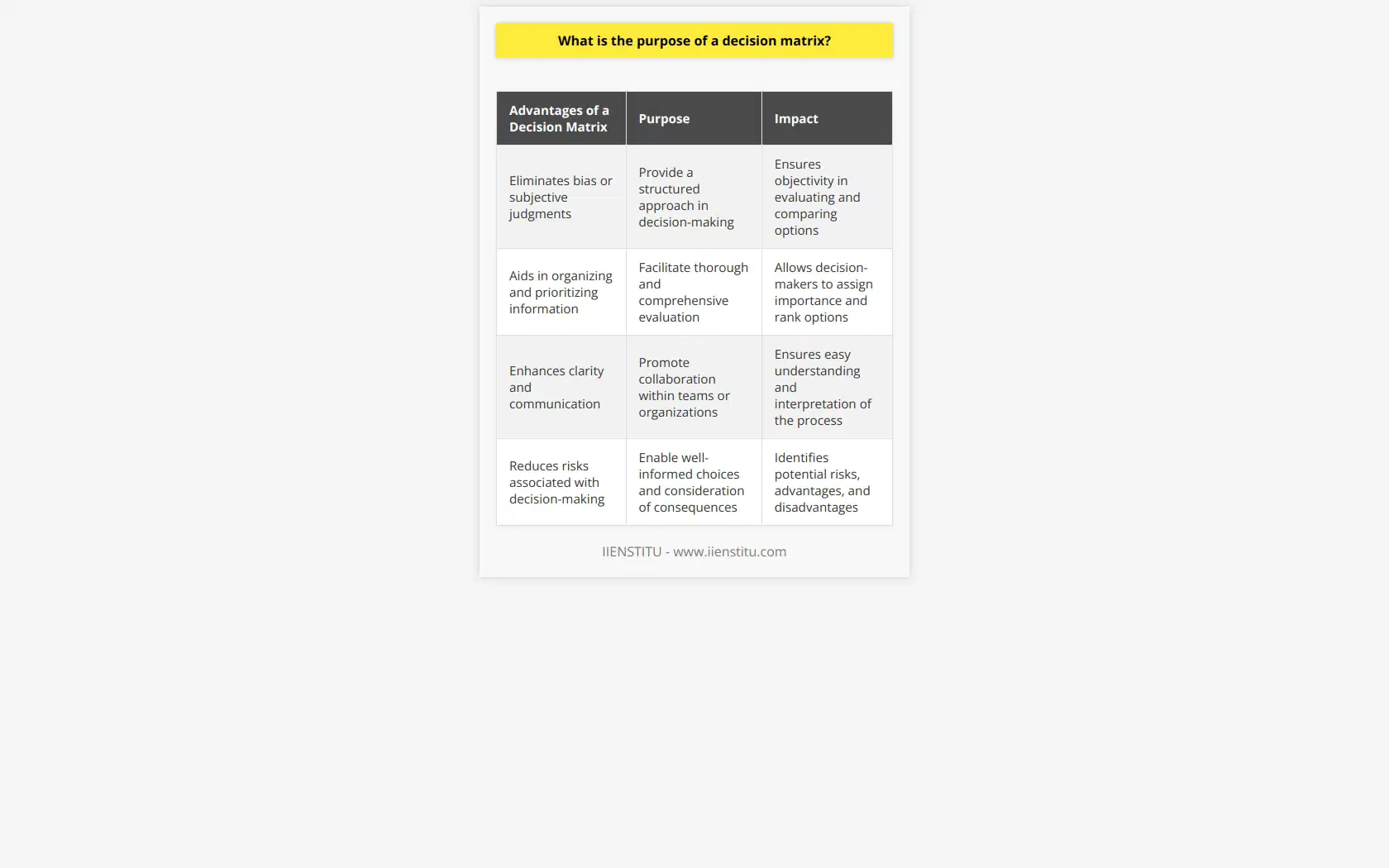
What is the difference between a basic decision matrix and a weighted decision matrix?
A fundamental decision matrix compares alternatives based on multiple criteria. In contrast, a weighted decision matrix assigns weights to criteria, making the evaluation more accurate and efficient by considering the relative importance of each criterion.
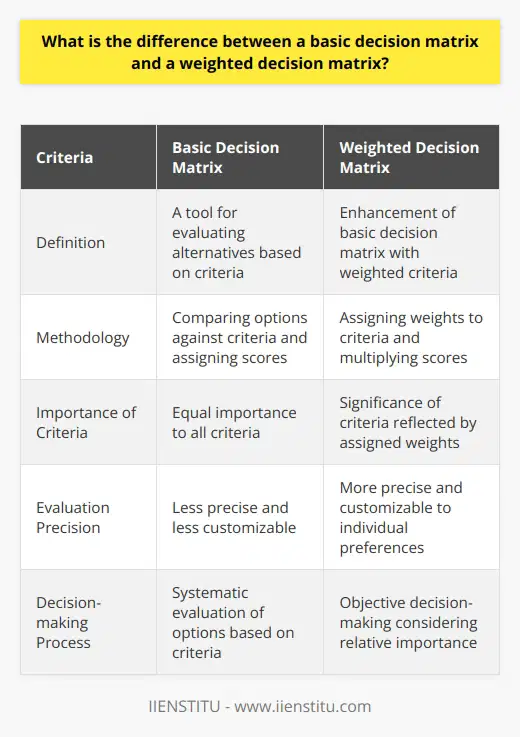
How does the Pugh Matrix differ from other decision matrices?
The Pugh Matrix, or Pugh Decision Matrix, is an advanced decision-making method that compares each alternative against a baseline or datum. This allows for a relative comparison of options and is particularly useful when dealing with complex decisions.
